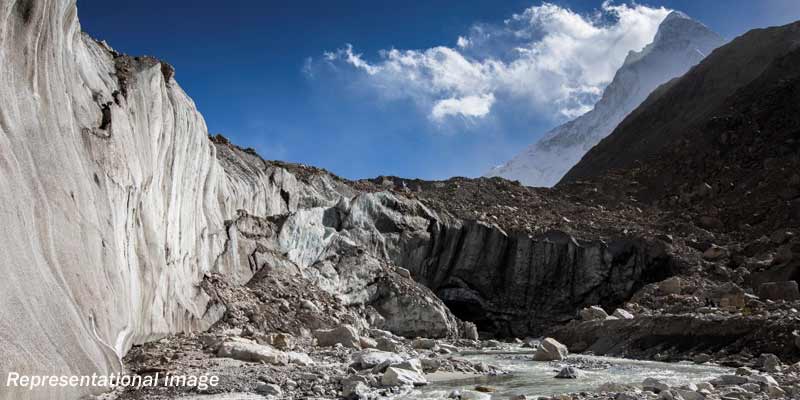- India
- Apr 24
Glacial lakes expanding in Himalayan region, warns ISRO
• More than 27 per cent of the identified glacial lakes in the Himalayas have notably expanded since 1984 and 130 of those are in India, Indian Space Research Organisation (ISRO) said.
• Long-term satellite imagery covering the catchments of Indian Himalayan river basins from 1984 to 2023 indicates significant changes in glacial lakes.
• Of the 2,431 lakes larger than 10 hectares identified during 2016-17, 676 glacial lakes have notably expanded since 1984.
What are glacial lakes?
• The Himalayan arc is young and tectonically active, formed as a result of massive collision between Eurasia and the northward drifting Indian plate about 50 million years ago. It forms the northern limit of India.
• The Hindu Kush–Karakoram–Himalayan region hosts the largest and most important glacier systems outside the poles and is commonly referred to as the “Third Pole” on the Earth.
• A glacial lake is formed when a glacier erodes the land, and then melts, filling the depression created by the glacier.
• These bodies of water play a crucial role as freshwater sources for rivers in the Himalayan region.
• Glaciers across the globe have been experiencing unprecedented rates of retreat and thinning due to human-caused climate change.
• This retreat leads to the formation of new lakes and the enlargement of existing ones in the Himalayan region.
The glacial lakes are categorised based on their formation process into four broad categories:
i) Moraine-dammed (water dammed by moraine)
ii) Ice-dammed (water dammed by ice)
iii) Erosion (water dammed in depressions formed by erosion)
iv) Other glacial lakes.
• Glacial lakes also pose significant risks such as Glacial Lake Outburst Floods (GLOFs), which can have devastating consequences for communities downstream.
Glacial Lake Outburst Flood (GLOF)
• Flash floods caused by the outburst of glacial lakes, called as Glacial Lake Outburst Flood (GLOF), are well known in the Himalayan region where such lakes had often been formed by landslides.
• GLOFs have immense potential of flooding in downstream areas, causing disastrous consequences due to release of large volumes of water in a very short interval of time.
• Glacial lakes release large volumes of meltwater due to the failure of natural dams, such as those made of moraine or ice, resulting in sudden and severe flooding downstream.
• These dam failures can be triggered by various factors, including avalanches of ice or rock, extreme weather events, and other environmental factors.
• Most often, the consequences arising out of such situations are highly unpredictable primarily due to lack of availability of sufficient data regarding rainfall intensity, location of landslide, impounded volume and area and physical conditions of lakes/ water bodies.
• GLOFs are not a new phenomenon but with the worldwide receding of glaciers and rising temperature the probability of their occurrences has risen in many mountain ranges.
• The frequency of GLOF events has been increasing since the second half of the 20th century due to the combined effects of climate change and deforestation.
Key findings by the ISRO:
• Monitoring and studying the occurrence and expansion of glacial lakes in the Himalayan region is challenging due to inaccessible and rugged terrain.
• Satellite remote sensing technology proves to be an excellent tool for inventory and monitoring due to its wide coverage and revisit capability.
• Assessing long-term changes in glacial lakes is crucial for understanding glacier retreat rates, assessing GLOF risks, and gaining insights into climate change impacts.
• ISRO said 601 of the 676 lakes have expanded more than twice while 10 lakes have grown between 1.5 to two times and 65 lakes 1.5 times.
• It said 130 of the 676 lakes are situated within India, with 65, seven, and 58 located in the Indus, Ganga and the Brahmaputra river basins, respectively.
• An elevation-based analysis revealed that 314 lakes are located in the 4,000-5,000-metre range and 296 above 5,000 metres.
• Among the 676 expanding lakes, the majority are moraine-dammed (307), followed by erosion (265), other (96), and ice-dammed (eight) glacial lakes.
• ISRO highlighted long-term changes in the Ghepang Ghat glacial lake (in the Indus basin) at an elevation of 4,068 metre in Himachal Pradesh, showing a 178 per cent increase in size from 36.49 hectares to 101.30 hectares between 1989 and 2022. The rate of increase is about 1.96 hectares per year.
• In October, at least 40 people were killed and 76 went missing in Sikkim after the South Lhonak Lake, a glacial lake situated in the state’s northwest at 17,000 feet, burst due to incessant rains.
Manorama Yearbook app is now available on Google Play Store and iOS App Store

